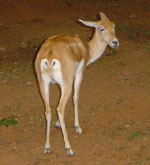By Dr.Susan Sharma
 The black buck is a true antelope, one of the most beautiful to look at. It is related to the springbok and the gerenuk in Africa, as well as the various gazelle species. The blackbuck probably evolved within the Indian subcontinent. Indian
art during the Mughal period pictured this antelope along with the graceful cheetah as black buck was one of the main prey of the cheetah. Decrease in their numbers must have indirectly affected the cheetah population which is now extinct.
The black buck is a true antelope, one of the most beautiful to look at. It is related to the springbok and the gerenuk in Africa, as well as the various gazelle species. The blackbuck probably evolved within the Indian subcontinent. Indian
art during the Mughal period pictured this antelope along with the graceful cheetah as black buck was one of the main prey of the cheetah. Decrease in their numbers must have indirectly affected the cheetah population which is now extinct.
The antelope is regarded as a symbol of fertility and villagers around the Little and Great Ranns of Kutch will give up their lives to protect the black buck.
Adult black buck males stand 80 cm ( 32in) at the shoulder and weigh an average of 40 kg ( 90 lb). The females and juveniles are coloured yellowish brown. After the age of three or so, the coat of the males darkens. In a mature male, the neck, the back, the
sides, part of the face and the outside of the legs are black. Contrasted to its white chest, abdomen, rump and tail, the pattern is striking. Like other male antelope, blackbuck carry permanent horns, which are not shed annually ( as are deer antlers).
Velavadar Blackbuck National Park in Gujarat has large congregations of blackbuck. The population in Kanha National Park has disappeared as the short grasslands preferred by blackbucks gave way to taller grass preferred by "barasingha", an endangered species
of deer. Thanks to the concerted efforts of the "Bishnois" ( Read about them by clicking here) black buck are found in open agricultural habitat in the villages. The Asola Wildlife Sanctuary in Delhi has a small population of black bucks which attract the
odd tourist.
( Photograph of female blackbuck at Asola by Amit Thomas)